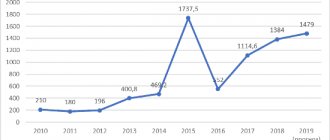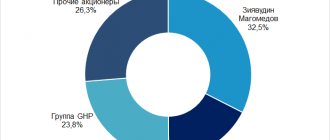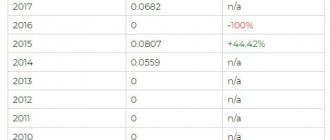Preferred shares (PA) are shares with a number of privileges. The owner of this type of securities is deprived of the right to vote at a meeting of shareholders, but receives certain privileges. They are what distinguishes an ordinary share from a preferred share. One of them is the receipt of constant income from securities. If the company cannot consistently pay dividends, the right to vote at the meeting is restored.
What are ordinary shares, how do they differ from preferred shares ?
Share privileges
Securities of this type are distinguished by the following privileges:
- Stable dividend payment.
- The right to part of the organization's property upon its liquidation.
- Probability of conversion into standard shares.
- The right to vote in the reorganization of the enterprise, restructuring, liquidation, amendments to the charter.
- Obtaining full voting rights in the event that the company can no longer make payments.
The main advantage of shares is the constant receipt of dividends.
the weighted average number of ordinary shares outstanding calculated ?
Features of Russian preferred shares
In Russia, most preferred shares are traded cheaper than ordinary shares. Among the reasons are the following:
- High trading turnover. For AO they are usually higher than for AP. The liquidity factor is an important reason for the more modest cost of preferred shares. According to the law, their number cannot exceed 25% of all shares.
- Payment for the opportunity to control the company's activities. The high demand for joint-stock companies is due to the fact that their presence may be required to ensure voting rights. Hence the higher price of common shares. Even large minority shareholders are sometimes forced to resort to purchasing them.
- Accessibility for foreigners. It is difficult for foreign investors to buy our preferred shares, since they are not sold on the stock exchanges of London and New York. Previously, APs were extremely rarely included in foreign investment funds or structured products. Only in recent years the situation began to change, as a result of which the price spread was reduced to approximately 10-20%.
When does it make sense to issue preferred shares?
Any company needs financing. You can obtain the necessary funds in various ways. Stocks are one of those routes. They allow the company to receive the necessary funds, and shareholders to receive dividends, as well as participate in the management of the organization.
It makes sense to issue preferred shares in the following cases:
- The company has the resources to consistently pay dividends.
- The owners of the organization do not want to allow strangers to manage the company.
As a rule, PAs account for 25% of the total volume of securities. That is, they occupy an intermediate value between ordinary stocks and bonds. These shares prevent the emergence of a large number of shareholders with voting rights.
How are dividends paid on preferred shares ?
Pros and cons of such promotions
The main difference between preferred shares and ordinary shares is the limited voting rights at meetings of security holders, as well as the presence of privileges. Let's look at their benefits for shareholders:
- Preemptive right when distributing dividends.
- Preemptive right to receive funds in the event of company bankruptcy.
- The right to receive a specified amount of funds if the company makes a profit.
- The right to vote during liquidation and reorganization of an organization.
The main advantage of a company when issuing PAs is the limitation of the voting rights of shareholders in managing the organization.
Let's look at the disadvantages of PA:
- Limitation of voting rights in company management.
- Relatively small dividends.
For a company, the main disadvantage of preferred shares is the need for stable dividend payments.
Restrictions on dividend payments
Article 102 of the Civil Code of the Russian Federation also raises the issue of restrictions that are imposed on the company, namely its obligations to pay dividends.
In accordance with established standards, dividends can be paid to shareholders only if the company's activities are profitable and there are enough funds to pay off all debt obligations.
Thus, restrictions on the payment of dividends are imposed on JSC in the following situations:
- If full payment of the authorized capital has not been made;
- If the total price of net assets shows lower indicators than the value of the authorized capital or stabilization fund;
- If, when making payments, the total monetary value of net assets decreases to the extent that the authorized capital in monetary terms will be significantly higher.
Author of the article
Varieties
Preferred shares are divided into the following categories:
- Regular PA . Holders of these securities receive benefits in exchange for voting rights. When distributing dividends, shareholders receive a priority right to receive payments.
- Cumulative or accumulating shares . These securities feature similar benefits. Their difference from ordinary PAs is the established period for accumulating dividends. If the funds are not received by the shareholder within the specified period, the person receives the right to vote at the general meeting.
An analogue of a PA is a founders' share. This is a security that can only be received by the founders of the company. The promotion provides a number of privileges:
- Additional votes at the meeting.
- Preemptive right to receive shares upon issue.
- Obtaining a leading role in resolving issues regarding the work of a joint-stock company.
Bearer shares imply free purchase and sale of these securities on the secondary market. In this case, there is no need to re-register the shareholder.
Non-payment of dividends
Dividends are a share of a company's income divided by the number of shares. According to Article 42 of the Law “On Joint Stock Companies”, the company pays dividends from net profit and special funds. Net profit is the income remaining after paying salaries, taxes, and debts. And special funds are created to pay dividends when the company has too much money.
The amount of dividends is specified in the company's charter. This can be either an exact amount or a formula for calculating net profit.
First, the board of directors recommends allocating a certain amount to pay dividends. The final decision on payments is made by the owners of ordinary shares at a meeting of shareholders. And the size of dividends cannot be higher than the value agreed upon by the board of directors.
But it happens that the owners of preferred shares are not paid dividends: there is no profit, there are no special funds for payment. In case of non-payment, you will have the right to vote on all company matters. But other options are possible; you need to look at the company’s charter. The law allows the conversion of shares into cumulative and converted shares.
Cumulative shares accumulate dividend debt for a certain period specified in the charter. In case of delay, your shares will receive voting rights. Convertible - give voting rights until the company pays the dividend debt.
Excerpt from the charter of Rosseti. Owners of preferred shares receive voting rights if they do not receive dividends
That is, in the event of non-payment of dividends, the company can choose from several alternatives. Of course, you can find out about all the conditions in advance. The dividend policy is described in the charter of the joint stock company. It is usually published on the website in the “investors and shareholders” section.
Difference 2.
Preference share rates
The dividend rate is determined depending on the following values:
- Profit received over a given period of time.
- JSC policy in the field of dividends.
- Goals of the company and its shareholders.
If the organization is in the development stage, the size and rates of dividends may be minimal. If the stock price decreases, it makes sense to increase the dividend rate. This will attract investors.
The dividend rate is the income on one security at the end of a given time period (quarter, year). The distribution of funds should be carried out evenly. The total amount of dividends received by a shareholder depends on the number of shares he currently holds. The rate can be expressed either numerically or as a percentage.
The rate is also divided into the following types:
- Fixed . Does not change throughout the entire time.
- Changing . It varies depending on the goals of the organization, as well as the size of its profit.
The rate is charged only on those shares that have been fully paid. The rate is set at the general meeting of shareholders. It can be changed based on statements from shareholders or participants in the general meeting.
Restrictions on the appointment and calculation of dividends
In some cases, the company cannot set the dividend rate and also make payments. Consider these cases:
- Incomplete payment of authorized capital.
- Failure to meet net asset requirements.
- The shares were not repurchased at the request of the holders.
- After dividends are paid, signs of bankruptcy are observed.
There is no interest rate on some securities. This applies to the following promotions:
- Securities that have not been offered and have not yet been issued.
- Acquired and on the balance sheet of organizations.
- Assets on the company's balance sheet due to a violation of the buyer's obligations.
For shares with the listed characteristics, accruals are also not performed.
Conditions and procedure for payment of dividends by a joint stock company
One of the most pressing issues is the payment of dividends to all holders of securities of a joint stock company. It is also under government control and is subject to certain rules and restrictions.
In particular, according to the established rule, the total amount of shares in monetary equivalent should not exceed the amount of the authorized capital or the amount of security provided by third parties. The decision to pay all dividends in this case can be made only if the enterprise has net assets the size of which will exceed the amount of the authorized capital.
Before deciding to pay all dividend payments and starting to formulate a payment procedure, it is necessary for management structures to demonstrate financial documents.
If they show the availability of the necessary funds for payments, then the entire amount will be distributed among the holders of the company's shares. If the company has significant debt obligations, then the decision to pay dividends may be postponed until the situation with securing obligations to creditors stabilizes.
Formula for determining the dividend rate
The dividend rate is determined by the following formula:
Rd = Div / P * 100%
Where:
- Rd – dividend rate,
- Div – amount of dividend payments,
- P is the price of one share at the moment.
The rate of preferred shares must correspond to the amount fixed in the organization's charter. It allows you to understand how many dividends a shareholder will receive from a security.
An example of calculating the dividend rate
A person purchased a share for 10,000 rubles. The amount of dividend payments is 1,000 rubles. The following calculations are carried out:
1 000 / 10 000 * 100% = 10%
That is, the dividend rate is calculated at this rate.
Voting at a meeting
Only holders of common shares vote on most issues. The principle is simple: one share - one vote. For example, at the end of June 2021, Aeroflot shareholders voted on the approval of annual profits, payments of remuneration to members of the board of directors, as well as on the approval of upcoming major transactions.
The scope of rights of holders of ordinary shares varies depending on the number of shares. However, we will disappoint those who plan to gain control in large companies: in most of them, significant stakes have been purchased by the state.
| How many shares are there? | What is possible |
| 1 % | View the list of other shareholders. File a lawsuit against the general director or a member of the board of directors demanding compensation for losses caused to the company |
| 2 % | Propose candidates to the Board of Directors. Introduce proposals to the agenda of the annual meeting of shareholders |
| 10 % | Call an extraordinary meeting of shareholders, even if it is rejected by the board of directors |
| 25% + 1 share | Block decisions of the board of directors |
| 50% + 1 shares | You can make your own decisions on most issues where 75% “yes” votes are not required |
| 75% + 1 share | You can make any decisions regarding the management of the company |
There are several topics that cannot be discussed without the preference shareholders. This is everything related to the liquidation of a company, reorganization, change in charter, placement of new shares on the stock exchange or withdrawal of existing ones from circulation.
Difference 3.
Should you buy preferred shares?
Preferred shares typically have relatively low yields. However, their advantage is a stable income. The attractiveness of a particular valuable stock is determined based on the following factors:
- Current share price.
- The expected future value of a security.
- Nominal cost.
Preferred shares make sense for those shareholders who are interested, first of all, in receiving income. They will be able to receive regular dividends. This is not a suitable option for people who seek to influence the development of the company.
How to earn? Which stocks are more profitable?
The serious difference between the prices of preferred shares and ordinary shares is a good opportunity to make money in the medium and long term. In Russia, the market underestimates AP. It is difficult to say how long this situation will last. By reducing the difference in prices between these securities, you can make money on paired transactions: buying AP while simultaneously selling JSC of selected issuers. This option will exhaust itself over time. The difference in prices for paired shares of most companies has already significantly decreased.
An investor choosing between AP and JSC can be advised to proceed from the specific situation. If the company is on the rise, the common stock is likely to rise in value faster. However, if the difference between them is at least 15%, then the preferred shares will most likely bring more money over the long term. Higher returns will be achieved through impressive dividends and reinvestment of received payments.
- Related Posts
- Dividends on shares
- Types of securities: shares, bonds, bank certificates, bills of exchange
- How to ensure a dignified old age: stock trading in retirement










